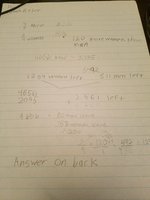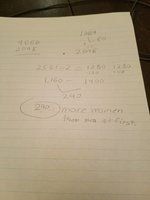This is the word problem,
4656 people at a concert. after 4/5 of the men leave, and 3/4 of the women left the concert hall, there were 120 more women than men who remained behind. How many more women than men were there at 1st?
this is the work my son has tried to do. is this anywhere close?
4656 people at a concert. after 4/5 of the men leave, and 3/4 of the women left the concert hall, there were 120 more women than men who remained behind. How many more women than men were there at 1st?
this is the work my son has tried to do. is this anywhere close?


